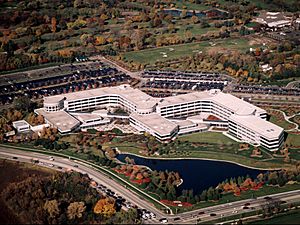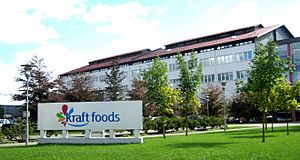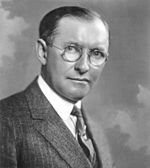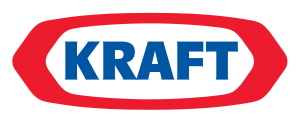Kraft Foods Inc. facts for kids
 |
|

Kraft headquarters in Northfield, Illinois
|
|
| Public | |
| Industry | Food |
| Fate | Split into two companies, Mondelez International and Kraft Foods Group |
| Successor | |
| Founded | 1909 (as J.L. Kraft and Bros. Company) December 10, 1923 (as National Dairy Products Corporation) |
| Founder | James L. Kraft (as J.L Kraft and Bros. Company) Thomas H. McInerney Edward E. Rieck (as National Dairy Products Corporation) |
| Defunct | October 1, 2012 |
| Headquarters | Northfield, Illinois, U.S. |
|
Area served
|
Worldwide |
|
Key people
|
Irene Rosenfeld (chairman & CEO) |
| Products | Processed food |
Kraft Foods Inc. was a very large company that made many kinds of sweets, foods, and drinks. It sold its products in over 170 countries around the world. Twelve of its brands made over $1 billion each year. These included Cadbury, Jacobs, Kraft, LU, Maxwell House, Milka, Nabisco, Oreo, Oscar Mayer, Philadelphia, Trident, and Tang. Many of its brands were also over 100 years old.
The company's main office was in Northfield, Illinois, which is close to Chicago.
Kraft was listed on the New York Stock Exchange. In 2011, the company announced it would split into two new companies. One would focus on grocery products in North America, and the other would be a global snacks company. The snack company, Mondelez International Inc., became the new name for Kraft Foods. The grocery company was named Kraft Foods, which is now part of Kraft Heinz.
History of Kraft Foods
How the Company Started
Kraft Foods began with the National Dairy Products Corporation, which started on December 10, 1923. It was founded by Thomas H. McInerney and Edward E. Rieck. The company's first goal was to buy many small ice cream companies in the United States. By buying these companies, it grew to include all kinds of dairy products. By 1930, it was the biggest dairy company in the U.S. and the world.
Thomas McInerney ran an ice cream company in Chicago. In 1923, he went to people who help companies get money to fund his idea. He wanted to combine many ice cream companies in the U.S. He convinced groups like Goldman Sachs and Lehman Brothers to help him.
This led to the creation of National Dairy Products Corporation in 1923. It was formed by combining McInerney's Hydrox company with Rieck McJunkin Dairy Co. The new company's shares were sold on the New York Stock Exchange. More people wanted to buy shares than were available.
The company grew quickly by buying many other businesses. Between 1923 and 1931, National Dairy Products Corporation bought over 55 companies. Here are some of the important ones:
| Year | Company | Type of Business | Location |
|---|---|---|---|
| 1924 | W.E. Hoffman | Ice cream | Pennsylvania |
| 1925 | Dunkin Ice Cream | Ice cream | Illinois |
| 1925 | Sheffield Farms | Milk, ice cream, other | New York |
| 1926 | Breyer's Ice Cream | Ice cream | Pennsylvania |
| 1928 | Breakstone Brothers | Milk, cheese | New York |
| 1928 | General Ice Cream | Ice cream | New York, East Coast |
| 1929 | Hiland Dairy | Milk, other | Kentucky |
| 1930 | Kraft-Phenix | Cheese, other | US, international |
| 1931 | Consolidated Dairy Products | Ice cream, other dairy | New York, New Jersey |
The Start of Kraft
James L. Kraft was born in Canada in 1874. He moved to the United States in 1903. He started a business in Chicago where he sold cheese to stores from door to door. His first year was not good, as he lost money and even a horse. But his business improved, and in 1909, his four brothers joined him to form J.L. Kraft and Bros. Company.
In 1912, the company set up its main office in New York City to get ready to expand around the world. By 1914, they were selling 31 different kinds of cheeses across the U.S. This was thanks to new products, good marketing, and opening their own cheese factory in Stockton, Illinois.
In 1915, the company invented a special pasteurized processed cheese. This cheese did not need a fridge, so it lasted much longer than regular cheese. They got a patent for this process in 1916. During World War I, they sold about six million pounds of this cheese to the United States Army for soldiers' meals.
In 1916, Kraft started advertising across the country. They also bought their first company, which was a Canadian cheese company.
In 1924, the company changed its name to Kraft Cheese Company and was listed on the Chicago Stock Exchange. In 1926, it was listed on the NYSE. The company then began to buy other dairy companies in the U.S., competing with National and Borden. Some companies they bought included:
| Year | Company | Type of Business | Location |
|---|---|---|---|
| 1927 | A.E. Wright | Salad dressings | n/a |
| 1928 | Phenix Cheese | Cheese, other dairy products | National |
| 1928 | Southern Dairies | Milk, milk powder, other dairy products | U.S. South |
| 1928 | 10 "cheese dealers" | Cheese, other dairy products | New York |
| 1928 | Henard Mayonnaise Co | Mayonnaise | n/a |
| 1929 | D.J. Easton | Mayonnaise | New Jersey |
| 1929 | 2 other mayonnaise companies | Mayonnaise | n/a |
| 1929 | 10 companies | Cheese, other dairy products | various regional |
| 1929 | International Wood Products | n/a | n/a |
In May 1926, the Kraft Walker Cheese Co. was started in Australia. It was a separate company but managed by the same people as Fred Walker & Co. Fred Walker was the chairman by 1930. After he passed away in 1935, Kraft bought the company.
Later, in 1927, Kraft opened sales offices in London, United Kingdom, and Hamburg, Germany. These were its first steps outside North America. Sales for 1927 were $60.4 million.
In 1928, Kraft bought Phenix Cheese Company, which made cream cheese called Philadelphia cream cheese. After this, the company changed its name to Kraft-Phenix Cheese Company.
By 1930, Kraft had 40% of the cheese market in the U.S. It was the third largest dairy company in the United States.
After National Bought Kraft-Phenix
When National Dairy bought Kraft-Phenix in 1930, National Dairy was much larger. National Dairy's leaders managed the combined company. The company continued to be called National Dairy until 1969, when it changed its name to Kraftco.
At first, all of the company's sales came from dairy products. But the company started making other things like caramel candies, macaroni and cheese dinners, and margarines. From the 1950s, the company began to move away from simple dairy products like milk. Over time, cheese became the main dairy product the company made.
In 1933, the company started advertising on the radio. In 1935, the Sealtest brand of ice cream was launched. This was a single national brand to replace the many local brands the company had.
During World War II, the company sent four million pounds of cheese to Britain every week.
New products and advertising helped the company grow after the war. They launched sliced processed cheese and Cheez Whiz in the 1950s.
During these years, the founders of National Dairy and Kraft passed away. By the end of the 1950s, the different parts of the company became less independent. They even started a glass-packaging business by buying Metro Glass in 1956.
In 1947, the company tried advertising on the new medium of television. They produced a TV show called the Kraft Television Theatre. They advertised a product called MacLaren's Imperial Cheese on the show. This product had not been advertised before and had not been sold for several years. But after the show, grocery stores could not keep up with the demand for it.
In the 1960s, the company created many new products. These included fruit jellies, marshmallows, barbecue sauces, and Kraft Singles, which are individually wrapped cheese slices. During this time, the company also grew in many countries around the world.
In 1961, the company bought Dominion Dairies of Canada. This was its first step into selling milk and ice cream outside the U.S. In the same year, it also bought The Southern Oil Company in Manchester, England.
National Dairy Becomes Kraft
In 1969, the company changed its name from National Dairy to Kraftco Corporation. The company said the reason for the name change was that it had grown far beyond just milk and ice cream. In 1969, its original products made up only about 25% of its sales.
In 1972, the company moved its offices to Glenview, Illinois. In 1976, its name changed again to Kraft, Inc. This was to highlight the Kraft brand, which the company was well-known for. Also, dairy products, other than cheese, were now only a small part of the company's sales. The company also reorganized after the name change.
Dart Merger
In 1980, Kraft joined with Dart Industries. Dart Industries made Duracell batteries, Tupperware plastic containers, West Bend home appliances, and other products. Together, they formed Dart & Kraft.
During the 1980s, Dart & Kraft had mixed results. They bought new food businesses like Churny cheeses and Lender's Bagels. But their non-food businesses, like Tupperware, were not doing well. So, Dart & Kraft decided to separate its non-food businesses (except Duracell batteries) into a new company called Premark International, Inc. Dart & Kraft then changed its name back to Kraft, Inc.
Philip Morris Buys Kraft and Merges with General Foods

In 1988, Philip Morris Companies bought Kraft for $12.9 billion. In 1989, Kraft joined with Philip Morris's General Foods unit. General Foods made products like Oscar Mayer meats, Maxwell House coffee, Jell-O gelatin, Kool-Aid, Crystal Light, and Tang drink mixes, and Post Cereals. The new company was called Kraft General Foods. After this merger, the company slowed down in creating new products.
In 1990, the company bought Jacobs Suchard (a big European coffee and candy company) and Freia Marabou (a Scandinavian candy maker). This helped Kraft grow outside the U.S. In 1993, it bought RJR Nabisco's cold cereal business, which included Shredded Wheat. It also sold its Breyers ice cream division to Unilever.
In 1995, the company changed its name to Kraft Foods, which it kept until the split. The same year, it sold its bakery division and its candy division.
By 2007, Philip Morris (now Altria Inc.) had sold its shares in Kraft foods. The two companies were no longer connected.
Growing Financially
In 2000, Philip Morris bought Nabisco Holdings for $18.9 billion and combined it with Kraft Foods. In 2001, Philip Morris sold some Kraft shares in a very large public offering.
In 2004, Kraft sold its sugar candy division to Wrigley. It also sold other smaller brands, like its hot cereal division to B&G Foods in 2007.
In 2006, the company bought the Southern European business of United Biscuits, gaining local brands like Galletas Fontanenda.
An investor named Nelson Peltz bought a small part of Kraft Foods. He talked with the company leaders about making the business better.
On January 31, 2007, the company announced that its shares would be given to Altria shareholders. This made Kraft an independent company that was publicly owned.
In July 2007, Kraft agreed to buy Groupe Danone's cookie and cereal division for $7.2 billion. This included the famous French cookie brand Lefèvre-Utile. People in France were not upset about this sale because Kraft promised not to close French factories and to keep the new division's main office near Paris for at least three years.
In November 2007, Kraft agreed to sell its cereal unit to Ralcorp Holdings for $2.6 billion. This money would help Kraft pay down its debt.
In February 2008, Berkshire Hathaway, run by investor Warren E. Buffett, announced it had bought a large part of Kraft.
On September 22, 2008, Kraft Foods joined the Dow Jones Industrial Average, replacing American International Group.
Buying Cadbury
On September 7, 2009, Kraft offered to buy the British candy company Cadbury for £10.2 billion. Cadbury makes Dairy Milk and Bournville chocolate. On November 9, 2009, Cadbury said no to Kraft's offer, calling it too low. Kraft made the same offer again on December 4, 2009. Many people in the United Kingdom were against the takeover.
On January 19, 2010, Cadbury finally agreed to a new offer from Kraft, which valued Cadbury at $19.5 billion (£11.5 billion). The money for this purchase came partly from the Royal Bank of Scotland.
The purchase of Cadbury was part of a plan by Irene Rosenfeld, who was the CEO and Chairman of Kraft. She wanted to help Kraft grow in new markets and offer more products. It was thought that buying Cadbury would help Kraft products grow in places like Brazil and India. This was because Cadbury already had a strong presence there. Kraft also thought that buying Cadbury was important because Nestlé and Hershey might join together. Kraft believed it could save at least $675 million each year by combining the companies. Irene Rosenfeld saw the merger as a way to build a "global powerhouse in snacks, confectionery and quick meals."
After buying Cadbury, Kraft had 14.8% of the world's candy and gum market. Kraft believed it could use Cadbury's distribution networks in growing markets like India, Brazil, and Mexico. As people in these countries earn more money, Kraft hoped that products like Oreo would become popular impulse buys.
At the time of the purchase, the chocolate and sugar industry was growing fast. Cadbury also owned popular gum brands like Stride, Trident, Dentyne, and Chiclets.
After the Acquisition
After Kraft bought Cadbury, Cadbury's sales did not grow much. Even though the Cadbury takeover helped boost Kraft's overall sales, Kraft's profit went down. This was because of the costs of combining the UK business after the purchase. Kraft spent $1.3 billion to combine the companies.
Kraft had to raise prices to cover the rising costs of ingredients like corn, sugar, and cocoa. In March 2011, Kraft caused anger when they sold the site of a historic Cadbury factory for £50 million. Kraft had promised not to close this factory to get support for the deal. Instead, production was moved to Poland. The Somerdale Factory closed just days after Kraft Foods took over.
Sale of Frozen Pizza Business to Nestlé

On March 1, 2010, Nestlé bought Kraft's North American frozen pizza business for $3.7 billion. This sale included brands like DiGiorno, Tombstone, and Jack's in the United States. It also included two factories in Wisconsin. This business made $1.6 billion in sales in 2009 and had 3,400 employees.
Proposed Company Split
After a time of poor stock performance, Kraft's CEO, Irene Rosenfeld, announced in 2011 that the company would split into two new companies. Both would be listed on the New York Stock Exchange (later changed to NASDAQ). One company would keep the Kraft Foods name and brands, focusing on the North American food business. The second company, later named Mondelēz International, would focus on global snacks. This would include the former Cadbury businesses and global brands like Dairylea. On April 2, 2012, Kraft Foods Inc. announced its plan to split into two companies. Kraft Foods changed its name to Mondelez International and created Kraft Foods Group as a new public company.
Sponsorships and Promotions
Kraft Foods Inc. was a partner and sponsor of Major League Soccer. It also sponsored the Kraft Nabisco Championship, which is one of the four major golf tournaments for women. The company also sponsored the Kraft Fight Hunger Bowl, a college football game played after the regular season.
Kraft Hockeyville was a Canadian TV show that started in 2006. Kraft Foods sponsored it. In the show, communities across Canada competed to show how much they loved ice hockey. The contest was about community spirit in Canada.
In 2011, Kraft released an iPad app called "Big Fork Little Fork." This app had games and information on how to use Kraft foods in healthy ways.
Brands
Before the company split, its main businesses were in beverages, cheese, dairy foods, snack foods, confectionery, and convenience foods.
Kraft's major brands, which each made over $1 billion in sales, included:
- Cadbury
- Jacobs
- Kraft, including Kraft Dinner, Kraft Singles, Kraft Mayo
- LU
- Maxwell House
- Milka
- Nabisco
- Oreo
- Oscar Mayer
- Philadelphia
- Trident
- Tang
Seventy other brands made over $100 million in sales. In total, 40 brands were at least 100 years old.
In the News
In January 2004, Kraft began a major restructuring. This was after a year of lower sales, partly because Americans were becoming more interested in healthy eating. The company announced it would close 19 factories around the world and cut 5,500 jobs.
On January 19, 2010, Kraft completed the deal to buy Cadbury for over $19 billion.
On March 17, 2010, Kraft Foods said it was "truly sorry" for closing a Cadbury factory in Somerdale. A senior Kraft executive made a public apology to Members of Parliament.
In March 2011, in the U.S., Kraft Foods launched MiO. This is a liquid flavoring product with no calories or sugar, made for people aged 18 to 39. MiO has no artificial flavors but does have artificial colors, sweeteners, and preservatives.
In August 2011, Kraft Foods announced plans to split into two separate companies. One would be a snack food company, and the other a grocery company.
Recalls
In September 2000, Kraft recalled up to $50 million worth of taco shells from stores and Taco Bell restaurants. The shells contained genetically modified corn that was not approved for people to eat. This was the first recall of a genetically modified food.
In April 2009, Kraft Foods recalled products with pistachios. This happened after salmonella was found at one of its factories in Illinois. Kraft found that the problem came from a pistachio grower in California.
In September 2011, Kraft recalled over 130,000 cases of Velveeta Shells and Cheese microwaveable cups. This was because there might have been small pieces of wire in the cups.
See also
 In Spanish: Kraft Foods para niños
In Spanish: Kraft Foods para niños



